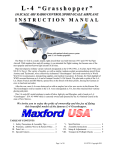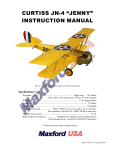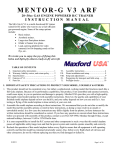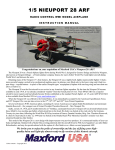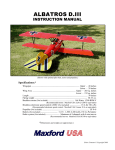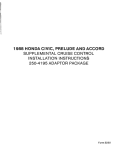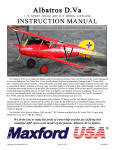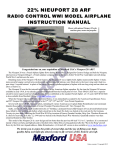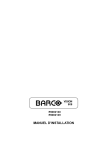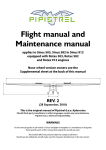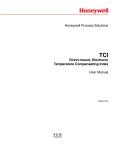Download Maxford L-4 Grasshopper Instruction manual
Transcript
L-4 “Grasshopper” 1/6 SPORT-SCALE ARF RADIO-CONTROLLED MODEL AIRPLANE INSTRUCTION MANUAL Shown with optional dummy engine, electric power system and 11 x 6 wood propeller. The Piper J-3 Cub is a small, simple, light aircraft that was built between 1937 and 1947 by Piper Aircraft. With tandem (fore and aft) seating, it was intended for flight training, but became one of the most popular and best-known light aircraft of all time. Piper developed a military variant variously designated as the O-59 (1941), L-4 (after April 1942), and NE (U.S. Navy). The variety of models, as well as similar, tandem-cockpit accommodation aircraft from Aeronca and Taylorcraft, were collectively nicknamed “Grasshoppers” and used extensively in World War II for reconnaissance, transporting supplies, and medical evacuation. In Europe, the final dogfight of WWII occurred between an L-4 and a German Fieseler Fi-156 Storch. The pilot and co-pilot of the L-4, Lts. Duane Francis and Bill Martin, opened fire on the Storch with their pistols, forcing the German air crew to land and surrender. After the war, most L-4s were destroyed or sold as surplus, but a few saw service in the Korean War. The Grasshoppers sold as surplus in the U.S. were redesignated as J-3s, but often retained their wartime glazing and paint. This 1/6 scale RC model airplane is made of balsa, light-ply and fiberglass, and is based on the original L-4 “Grasshopper” as used during World War II. We invite you to enjoy the pride of ownership and the joy of flying this beautiful model of the famous L-4 Grasshopper. TABLE OF CONTENTS I. II. III. IV. Safety Precautions & Assembly Tips .............. Warranty, Liability Waiver & Return Policy ... Parts List......................................................... Special Features ............................................. 2 3 3 4 V. VI. VII. VIII. Page 1 of 14 Specifications ..................................... 4 Assembly Instructions ......................... 4 Setup & Adjustments ........................ 12 Transport & Preflight Checks ............ 12 S121015 / Copyright 2012 I. SAFETY PRECAUTIONS & ASSEMBLY TIPS: (IMPORTANT – READ THIS SECTION BEFORE YOU BEGIN ASSEMBLY) 1. This product should not be considered a toy, but rather a sophisticated, working model that functions much like a full-scale airplane. Because of its performance capabilities, this product, if not assembled and operated correctly, could cause injury to you or spectators and damage to property. Maxford USA provides you with a high-quality, thoroughly tested model airplane kit with assembly instructions. However, the quality and capabilities of your finished model airplane depend on how you assemble it, and your safety depends on how you use and fly it. Any testing or flying of this model airplane is done entirely at your own risk. 2. Assemble this model airplane according to these instructions. Do not alter or modify the model beyond the assembly and power-system options covered in these instructions, as doing so may result in an unsafe or unworkable model. If the instructions differ from the photos, the written instructions should be considered as correct. If you have any question or concern about these instructions, before you proceed with assembly of this product, contact your dealer or speak to a Maxford USA customer service representative at 562-529-3988 (Monday through Friday, except national holidays, 9 AM to 5 PM Pacific time). 3. While this kit has been flight-tested to meet or exceed our rigid performance and reliability standards in normal use, if you elect to perform any extremely high-stress flying, such as racing or advanced aerobatics, or if you install a larger power system than specified, you (the buyer or user of this product) are solely responsible for taking any and all necessary steps to reinforce the high-stress points and/or substitute hardware that is more suitable for such increased stresses. 4. Throughout the lifetime of this model, use only the Maxford USA-supplied or a same-sized motor and a new or well-maintained radio-control system and batteries recommended by Maxford USA or your radio system. 5. It is your responsibility to install the receiver and connect the R/C components in such a way that this model airplane passes all applicable safety/range tests and that the power system and controls operate correctly and smoothly. 6. Recheck the operation of this model airplane before every flight to ensure that all equipment is still operating correctly and that the model has remained structurally sound. Also before every flight, check all electrical, control and structural connections; do not fly without replacing any that you find damaged or worn. 7. Before you begin assembly of this model airplane, read all instructions and test-fit each part to ensure you fully understand the instructions and that no parts are missing, damaged or unsatisfactory. (Note: Temperature and/or humidity differences between the factory, our warehouse and your home or workshop may indicate the need for slight adjustments to the wing saddle, struts and/or the vertical or horizontal stabilizer’s mounting surfaces to ensure proper alignment of these surfaces; however, we recommend you contact us before you attempt any such adjustments.) 8. To help ensure the security of your servo connections, we recommend use of optional Maxford USA servo extension safety clips. 9. If you are not an experienced R/C pilot or have not flown this type of model before, we strongly urge you to get assistance from an experienced R/C pilot. 10. You may use 30-minute epoxy to permanently attach critical parts (such as where the horizontal and vertical stabilizer attach at the end of the fuselage) and apply a threadlock compound to secure the engine’s or motor’s mounting hardware from vibration. 11. If you have concern about the security of any factory fabrication procedure(s), you may apply 30-minute epoxy around the perimeter of such part(s) as an extra safety precaution. 12. This model includes some plastic, fiberglass and/or carbon-fiber reinforced parts. If you drill, grind or sand such a part, always wear safety goggles, a particle mask and rubber gloves to guard yourself from eye, skin and respiratory-tract irritation and never blow into the part (the dust may blow back into your face). 13. Check the Mylar covering material’s joints and surfaces; if necessary, carefully use a dedicated coveringmaterial iron (do NOT set the iron’s temperature too high) to secure the edges and to tighten any loosened areas. Recheck and retighten from time to time. 14. Read all instructions included with your battery and charger. Failure to follow all instructions could result in permanent damage to the battery, its surroundings, and bodily harm! If you crash this model airplane, check whether the battery is damaged. Do NOT attempt to use or recharge a damaged battery. Page 2 of 14 S121015 / Copyright 2012 II. WARRANTY, LIABILITY WAIVER & RETURN POLICY: Maxford USA guarantees this kit to be free from defects in material and workmanship at the time of purchase. All our products have been inspected in our factory and are checked again when shipped from our warehouse. However, Maxford USA cannot directly control the materials you may use nor your final assembly process. Therefore, Maxford USA can NOT in any way guarantee the performance of your finished model airplane. Furthermore, in purchasing this product, you (the buyer or user of this product) exempt, waive, and relieve Maxford USA from all current or future liability for any personal injury, property damage, or wrongful death, and if you (the buyer or user of this product) are involved in any claim or suit, you will not sue Maxford USA or any of its representatives. If you do not fully accept the above liability and waiver, you may request a return-merchandise authorization number (RMA#) as explained below in item 2. If you think there is a missing, damaged or unsatisfactory part, please read our after-sales service and return policy: 1. Inspect your order upon delivery for any missing, damaged or unsatisfactory part(s). If you believe there is a problem, you must call us at 562-529-3988 (Monday through Friday except holidays, between the hours of 9 AM and 5 PM Pacific time) before you begin assembly and within 10 days from receipt of your purchase. During this telephone conversation, and with your support, we will determine how to resolve your concern. 2. To request a return-merchandise authorization number (RMA#), call 562-529-3988 (Monday through Friday except holidays, between the hours of 9 AM to 5 PM Pacific time). If we elect to issue you an RMA#, you must clearly mark this RMA# on the outside of the package. (No return or exchange will be authorized after 10 days from the date of your receipt of the product; any package delivered to us without a Maxford USA RMA# is subject to being returned to the sender, as received, with return postage payable upon delivery.) Returned merchandise must be in its original condition as received from Maxford USA, with no assembly or modification, in the product’s original packing materials, complete with all manuals and accessories. Return shipping and insurance charges must be prepaid by you, the buyer. 3. Returned merchandise that is accepted by Maxford USA for credit is subject to a 10% to 20% restocking fee (the final amount will be determined by Maxford USA upon receipt and examination of the returned merchandise). Return Address: Maxford USA 15939 Illinois Avenue, #B-C Paramount, CA 90723 IMPORTANT: Print the RMA# issued by Maxford USA near the above address. III. PARTS LIST: 1. Included items · · · · · · · All wood built-up construction, precovered with iron-on Mylar film. Windshield (with mounting screws). · Fiberglass cowl. Wing panels with V-shaped left & right wing struts. · Engine mount. Horizontal stabilizer & elevator. Vertical Stabilizer & Rudder. · Hardware bag. Main landing-gear assembly. · Complete set of scale markings. Scale-looking landing gear with wheels · This illustrated Instruction Manual. and two shock-absorbing springs. · Stearable tail gear. 2. Items you must supply · 5-minute epoxy and thin cyanoacrylate (CA) adhesives, threadlock compound. · Low-tack masking and transparent tape and common tools (such as screwdrivers and long-nosed pliers). · A four- (or more) channel radio system, 3 ea. standard and 2 ea. mini or equivalent servos (or 2 standard and 2 mini servos plus an electronic speed control if you use an electric power system), 2 ea. 12-inch servo extensions and 1 ea. 12-inch Y cable for aileron servos. · 40-class 2-cycle glow engine or equivalent 4-cycle glow engine or electric power system. · 11 x 6/7 wood prop. or as recommended by the maker of your engine or motor. Page 3 of 14 S121015 / Copyright 2012 · Optional upgrades: Dashboard, throttle control, dummy engine and floats. · Options required for EP conversion: U35425 motor, 60A electronic speed control (ESC), 2 ea. 3 cell 2100 mAh LiPo batteries, and connectors to run the batteries in parallel and connect the batteries to the ESC. IV. SPECIAL FEATURES: · Fully operational top- and bottom-hinged cabin side doors with concealed magnets to securely hold the doors open and closed. · Prepainted fiberglass cowl, realistic looking windshield, top and side windows. · Articulated landing gear with mains wheels, steerable tail wheel, and stick-on scale markings. · Quick-disconnect struts and easily removable two-piece wing panels for easy transport and storage. · Fuselage, wings and empennage are jig-assembled, laser-cut balsa and light plywood. · Designed with semi-symmetrical wing for better sport-scale aerobatic performance. · 95% preassembled ARF, designed for glow engine (with supplied engine mount and fuel tank for .40-sized glow engine) and an available motor mounting box for electric power operation. · Optional upgrades: Prepainted detailed true-to-scale dashboard, throttle control, dummy engine and floats. The dashboard and the throttle control are assembled and painted here in the USA. V. SPECIFICATIONS:* · · · · · Wingspan ................................................................................................................................. 70 inches Wing area .................................................................................................................... 718 square inches Length ...................................................................................................................................... 46 inches ARF weight ................................................................................................................. 4 pounds 8 ounces Power system .............................. 40-class 2-cycle glow engine (an engine mount and fuel tank included) (Optional: Equivalent 4-cycle engine or electric power system) · Propeller .......................................... 11 x 6/7 (or as recommended by the maker of your engine or motor) · Radio (not included) ........................................................................................... Minimum of 4 channels · Servos ........................................ 3 ea. standard and 2 ea. mini or equivalent servos (or 2 ea. standard and 2 mini servos plus an electronic speed control if you use an electric power system) * (Dimensions and weights are approximate.) VI. ASSEMBLY INSTRUCTIONS: 1. Fuselage-Mounted Servos – a. Remove the built-up and covered fuselage from its plastic bag. b. Using hardware supplied with your servos, install three servos in the servo tray (two servos if you are using an electric power system). c. Connect the EZ Link connectors to the servo arms. Guide the EZ Link connectors onto the rudder and elevator servos, and mount the servo arms onto the servos. d. Connect these servos to your receiver and position the receiver behind the servos. Page 4 of 14 S121015 / Copyright 2012 2. Engine (or Motor) and Cowl – a. If your use a glow-power engine, test-fit your engine, the engine mount, fuel lines, throttle pushrod and all related engine-mounting hardware as shown below. b. Using the spacing required by your engine’s mounting lugs, drill holes in the engine mounts and use engine mounting bolts, washers and nuts (#6-7-8 above) to securely attach your engine to the engine mounts. Test-fit the engine to the firewall using the vertical and horizontal guidelines drawn on the fire wall to set the prop. shaft with the recommended amount of right thrust and down thrust. Drill 4 holes in the firewall. c. Use engine mounting bolts (#4 above) and blind nuts (install the blind nuts behind the firewall) to attach the engine to the firewall. d. Drill a hole and direct the throttle pushrod (#10 above) from the throttle servo through the firewall. (Be careful to position the throttle pushrod’s hole so it will not interfere with the engine mount or fuel tank.) e. Position the fuel tank (#1 above) on its shelf inside the fuselage behind the firewall with the clunk and vent fuel lines passing through the firewall. f. In preparation to mount the engine cowl (#9 above), remove the muffler from your engine. g. As dictated by the design and dimensions of your engine, make opening in the engine cowl to access your engine’s needle valves, allow cooling air into the cowl, and to let the muffler exit the cowl. h. Attach the engine’s muffler to the engine with its provided hardware. i. If you install an electric power system, position your batteries and ESC on and beside the shelf behind the firewall. a) Use blind nuts and bolts to secure your motor and the motor-mounting box to the firewall. (Obtain the recommended amount of right thrust and down thrust by maintaining the “L” and “R” orientations marked on the sides of the motor-mounting box.) b) Protect the mounting bolts from vibration with threadlock compound or CA adhesive. c) Attach your ESC and confirm that the motor runs in the correct direction by connecting the ESC’s throttle lead to your Page 5 of 14 S121015 / Copyright 2012 radio receiver’s throttle channel; switch ON your transmitter and set transmitter’s throttle and throttle trim controls to minimum; with no propeller on the motor, switch ON your transmitter and connect the ESC to the battery; after you hear a series of initialization sounds, slowly raise the transmitter’s throttle to no more than 25% of maximum. d) Carefully run the motor slowly and only for the few seconds necessary to observe its direction of rotation. If the motor rotated in the clockwise (correct) direction as viewed from the rear of the airplane, return the throttle to minimum, disconnect the ESC from the battery, switch OFF the transmitter, and set your battery and transmitter aside. If the motor powered up in the counterclockwise (wrong) direction, return the throttle control to minimum, disconnect the ESC from the battery, swap either two of the three ESC-to-motor wires, and repeat the above procedure to ensure the motor rotates in the correct direction. j. If you are installing the optional dummy engine, use epoxy and/or wood screws to attach the mounting plates 1 3/4-inch above the bottom edges and close the side edge of the cowl. Approx. 1 3/4 inch k. Position the cowl so the propeller backplate protrudes approx. 1/4 inch beyond the face of the cowl; use low-tack masking tape to temporarily hold the cowl in position; use the provided 5/16-inch screws to attach the cowl; and remove the masking tape. 3. Main Landing Gear – (NOTE: If you are using floats, replace this section with the detailed instructions included with the floats.) a. As shown at the right, turn the fuselage upside down and attach the hinges by driving two bolts into the preinstalled blind nuts. b. Use two bolts and self-locking nuts to attach each landing gear strut to its hinge. Place one end of an 8-inch long spring under the two rearmost selflocking nuts. c. If necessary, bend the spring’s ends so the straight portion of the spring ‘points’ toward the opposing axle. d. Place flat washers on two 1 1/2-inch long bolts. Insert a bolt through the free end of each spring, guide the bolts into and through the holes in the ends of the main gear struts. (1/4-inch squares) e. Use a self-locking nut to secure the bolts and springs to the struts. f. Place a wheel onto the end of each 1 1/2-inch long bolt and use a self-locking nut to hold each wheel onto its axle. g. Apply a drop of CA adhesive to ensure each wheel is secured to its axle. (You may also choose to use a rotary tool with a cutting wheel to remove and discard the excess length of each bolt/axle.) Page 6 of 14 S121015 / Copyright 2012 4. Tail Surfaces – a. Test-fit the vertical stabilizer, rudder, horizontal stabilizer and both elevator halves to the fuselage. If necessary, cut through any Mylar covering the precut CA-hinge slots. (NOTE: Position the metal joiner in the horizontal stabilizer’s slot before sliding the horizontal stabilizer into its slot.) b. Ensure good wood-to-wood glue joints by trimming and removing the horizontal and vertical stabilizer’s Mylar covering that will be ‘burried’ inside the mounting slots in the fuselage. (Vert. Stab.) c. Slide the elevator’s metal joiner and the horizontal stabilizer into the horizontal slot at the end of the fuselage. Center and align the horizontal stab. at a right angle to the centerline of the fuselage, and secure it in place with epoxy. NOTE: Protect the wood by using the d. Use epoxy to secure the elevator’s metal joiner into hot tip of a soldering iron to trim each half of the elevator; then, before the epoxy the Mylar; do NOT use a knife-blade. cures, use thin CA and the supplied CA hinges to (Bottom side of the attach each half of the elevator to the horizontal Horizontal Stab.) stabilizer. e. Secure the vertical stabilizer into its slot in the fuselage with epoxy. Ensure the aft portion of the vertical stabilizer aligns with the end of the fuselage. f. Use a wheel collar to attach the tail wheel to its strut. g. Position the tail wheel strut’s mounting base onto the tail wheel’s (1/4-inch strut. squares) h. Test fit the tail wheel’s strut into its groove and the opening in the base of the rudder. (NOTE: It may be necessary to remove excess Mylar from the leading edge of the rudder.) i. Use epoxy to secure the tail wheel strut into the rudder. j. Attach the rudder to the vertictal stabilizer with CA hinges and thin CA. k. Use two 5/16-inch wood screws to attach the tail wheel strut’s mounting base to the bottom of the fuselage. l. Twist control horns onto the elevator’s and the rudder’s pushrods; use the supplied bolts and control horn backplates to secure one control horns to the rudder and the other to the elevator. 6. Aileron Servos and Ailerons – a. Test fit your aileron servos and prepare the aileron servo mounts by using epoxy to attach two servomounting pedestals to each servo hatch cover. b. Test-fit the ailerons to their wing panels, control horns and pushrods. (NOTE: Small holes in the Mylar show where to mount the aileron control horns; if necessary, you may reposition the aileron control horns to fit your servos; you might also need to slice through any Mylar that covers the precut CA-hinge slots.) Page 7 of 14 S121015 / Copyright 2012 c. Use the CA hinges and thin CA adhesive to attach the ailerons to their wing panels. Using the supplied control-horn bolts and backplates, attach the control horns to the ailerons. d. Mount the aileron servos to the servo hatch covers. Attach a 12-inch servo extension to each servo, install a servo and attached extension in each wing (1/4-inch panel, and secure the aileron servo hatch covers squares) with 5/16-inch wood screws. e. Use the supplied EZ Connectors to attach the aileron pushrods between each aileron control horn and its aileron servo. 7. Mount the Wing – a. Position and glue a spring retainer into the hole in the root rib of each wing panel. b. Insert both wingrods midway through the fuselage. c. Connect a 12-inch Y-cable to the radio receiver’s aileron port, then direct the two loose male ends of the Y-cable toward the rectangular openings on each the side of the fuselage. d. Slide both wing panels onto the wing rods and bring them toward the fuselage. e. As each wing panel is moved close to the fuselage, attach its aileron extension to the aileron’s Y-cable. (NOTE: We recommend you use optional servo extension safety clips for your safety.) f. Connect one end of the coil-spring to either one of the two spring retainers, as shown above and at the right. (1/4-inch squares) Page 8 of 14 (NOTE: See spring connection instructions at the top of the next page.) S121015 / Copyright 2012 g. As shown on the preceding page, guide the loose end of the spring and both sets of aileron wires into the fuselage as you continue to slide the wing panels toward the fuselage. h. As the root ribs meet the sides of the fuselge, reach into the cockpit, firmly grasp the loose end of the spring, stretch it toward the other side of the cockpit, and attach the loose end of the spring to the remaining spring retainer. i. Install the wing struts: a) Place your Grasshopper upside down on a soft surface and test-fit the wing struts to the fuselage and wing panels. (HINT: Observe the small holes in the Mylar that mark the areas of solid wood for attaching the outboard strut’s wood screws.) b) Loosely attach the wing struts to the fuselage using the preinstalled blind nuts and provided machine screws. (1/4-inch squares) c) If necessary, us pliers to bend the outboard ends of the struts to match the contour of the wing. d) Use 5/8-inch wood screws to attach the outboard ends of the struts to the underside of the wing. e) Use 5/16-inch machine screws and nuts to attach the approx. 115degree angled end of each wing-strut brace to the wing struts; use 1/4-inch wood screws to attach the right-angled end of each wing-strut brace to the bottom side of each wing panel. f) Secure the inboard ends of the struts to the fuselage by tightening both bolts into their fuselage-mounted blind nuts. 8. Finishing Touches – a. If you are using the optional detailed dashboard and throttle control, test-fit them, along with the carbon-fiber rod cockpit braces, inside the cockpit. (NOTE: The throttle control fits into the opening at the pilot’s left; position the carbon-fiber rod cockpit braces into the openings near the base of each front windshield frame, then squeeze their free, top ends inward and into the slots at the center-top of the cockpit; the dashboard rests on top the cockpit braces and against the framing for the forward turtle deck, as shown at the right.) b. Use thin CA adhesive to secure the throttle control, dashboard and cockpit braces. Page 9 of 14 S121015 / Copyright 2012 c. If you are not installing the optional throttle and dashboard, position the carbon-fiber rod cockpit braces, then secure them with thin CA adhesive. (NOTE: This space is for the throttle control.) (Insert the ends of carbon-fiber rod cockpit braces here and here.) d. You may use one or two optional Maxford USA 1/5-scale pilot figures; however, we recommend you construct a removable platform above the servos from lightweight scrap wood or plastic, then attach your pilot figure(s) to this platform. It helps if this platform is easily removable for access to the spring that connects the wing panels together and for adjustment or replacement of a fuselage-mounted servo. e. As pictured at the right, use sharp scissors to carefully trim and test-fit the excess molding-plastic from around the windshield. f. Once you have finished trimming and fitting the windshield, you may use the supplied 1/4-inch wood screws to hold it in position. (Some builders prefer to attach their windshields Typical amount and shape with transof the plastic removed parent tape or from the windshield. a suitablycolored automotive or hobby-grade trim tape.) g. Position the black wooden handle in the opening on the lower door panel. i. Secure the handle to the lower door panel with CA adhesive. j. Position the lower door panel in the bottom half of the opening on the right side of the fuselage. (NOTE: The built-in magnets are now holding the lower door panel securely in position.) k. Form an ‘invisible hinge’ along the entire width of the lower door panel by applying a strip of transparent tape between the outside surface of the lower door panel and the fuselage. (NOTE: Use only totally transparent tape; do not use the more popular ‘magic mending tape.’) Page 10 of 14 S121015 / Copyright 2012 l. m. n. o. p. q. Fully open the lower door panel. Apply a second strip of transparent tape to cover the full width of the lower door panel, from the inside surface of the lower door panel, across the ‘invisible hinge’ on the outside of the door, and onto the floor of the servo tray inside the cockpit. With the lower door panel still open, place the upper door panel in the top half of the opening, then close the lower door panel to hold the upper door panel in position. Use transparent tape to make an ‘invisible hinge’ along the entire width of the upper door panel on the outside surface of the upper door panel and the fuselage. Fully open the door’s bottom panel, then open the door’s top panel. (NOTE: As the upper door panel is brought close to the bottom side of the wing, a concealed magnet holds the top door panel open.) Apply a second strip of transparent tape covering the full width of the upper door panel, from the top inside surface of the upper door panel, across the ‘invisible hinge’ on the outside of the door, and onto the top of the door frame inside the cockpit. (NOTE: When the door is closed, the door’s bottom panel captures the lower portion of the door’s top panel. Always open the door’s bottom panel first, and always close the door’s top panel first.) Apply the stick-on aircraft markings: Trim with scissors Right and left sides are the same Apply near the bottom edge of the fuselage on both sides Right front of nose, only Apply to bottoms of both wing panels, next to the fuselage wing Apply to top of left wing and bottom of right wing r. If you have access to a suitable body of water, you may replace the fixed landing gear with a set of 40-sized Maxford USA floats. (NOTE: All of this L-4 Grasshopper’s optional upgrade items may also be purchased for use with the Maxford USA ARF sport-scale model of the Piper J-3 Cub.) Page 11 of 14 S121015 / Copyright 2012 VII. SETUP & ADJUSTMENTS: 1. Ensure all parts are secure and ready for flight. 2. Check and if necessary adjust the center of gravity: For your initial flight we recommend that your L-4 balance when lifted at a point approx. 2 9/16-inches (65 mm) behind the leading edge of the wing (when balanced, it should hang level; neither nose up nor nose down). 3. Check/adjust servo centering, direction and end-point adjustments: When you pull the right stick toward you, the elevator should deflect upwards; push the right stick to the right and the right aileron should deflect upwards and the left aileron should deflect downwards; push the left stick left and the rudder should deflect to the left as viewed from the rear of the fuselage. If you are using a Computer Radio: For initial flights set all linkages for near-max. possible deflections; then soften the aileron’s and elevator’s control throws by selecting 60% or more exponential and 30% exponential for the rudder. Initial settings if you are using a Non-Computer Radio: Recommended Deflection Elevator ..................................... 15 degrees (3/4 inches) up and down from center Rudder ....................................... 20 degrees (7/8 inches) left and right from center Ailerons ..................................... 15 degrees (1/2 inches) up and down from center 4. Check the Mylar covering material’s joints and surfaces. If necessary, carefully use an iron on medium heat to secure the edges and to tighten any loosened areas. Recheck and retighten from time to time. (Be carefull to NOT use too much heat when you secure edges or tighten the Mylar!) 5. Ensure all stick-on insignias and markings are secure in their positions. 6. Balance your propeller, then use the hardware supplied with your engine or motor to securely attach the propeller to the engine or motor. Congratulations! Assembly is finished! VIII. TRANSPORT & PREFLIGHT CHECKS: 1. Prepare your Grasshopper for transport and storage by disconnecting the struts at the fuselage and removing the spring that secures the wing inside the fuselage; safely set aside the strut-mounting bolts and spring for future use. As you slide the wing away from the fuselage, carefully disconnect both aileron servo extensions from the Y-cable. Separate the wing panels from their wing rods and safely transport and store your Grasshopper to await its next flight. 2. To prepare your Grasshopper for flight, reattach the wings by reversing the above procedure. As you slide the wing panels toward the fuselage, connect and guide the aileron servo extensions into the fuselage and reattach the spring inside the cockpit. (To help ensure the security of the servo connections, we recommend use of optional Maxford USA servo extension safety clips.) 3. Double-check the security of your engine (or the motor and its motor-mounting box) and make certain that all control surfaces, pushrods, screws and other connections are secure throughout the air frame. Doublecheck the control directions and amount of control throw of the ailerons, elevator and rudder. 4. As with all radio-controlled model airplanes, your Grasshopper must pass the radio range ground check recommended by your radio’s manufacturer or you may not fly safely. 5. Be sure your tank is filled with the fuel recommended by the manufacturer of your engine or the batteries are fully charged and able to provide the current demanded by your electric power system. 6. Whether you use a glow engine or an electric motor, for your safety we urge you to get into the habit of always moving your transmitter’s throttle to MINIMUM before turning ON your transmitter, and carefully operate your choice of radio and power system according to the manufacturer’s instructions. 7. If you are using a glow engine: Start the engine and set the needle valve according to your engine manufacturer's instructions. Advance the throttle to ‘full speed’ then lift and hold the Grasshopper at a 45-60 degree nose-up attitude for 10-15 seconds; during this time the engine should run smoothly with no appreciable loss of RPM. However, if your engine’s RPM ‘sags’ noticeably or if the engine dies from being either too rich or too lean, readjust the engine’s high-speed needle valve according to the engine manufacturer’s instructions. Page 12 of 14 S121015 / Copyright 2012 8. Whenever possible, point the nose of your Grasshopper into the wind for takeoff. As you advance the throttle, keep the nose pointed straight ahead as your Grasshopper picks up speed. Then, after the tail has lifted off and when you feel confident your Grasshopper has achieved adequate flying speed, give only a slight amount of UP elevator to gently climb to a safe altitude before attempting any other manuevers. Congratulations on your new L-4 Grasshopper. May you enjoy many Happy Landings! However, please remember … · The quality and capabilities of your finished model airplane depend on how you assemble it. · This product is NOT a toy. · Your safety depends on how you use and fly it. · Any testing, flying and use of this model airplane is done entirely at your own risk. · Please enjoy your hobby and fly safely! Manufactured by: Maxford USA RC Model Mfg, Inc. Distributed by: Maxford USA RC Model Distribution, Inc. 15939 Illinois Avenue, #B-C Paramount, CA 90723 Telephone (voice) ........... (562) 529-3988 Fax .................................. (562) 562-6988 Toll free (orders only) .... (866) 706-8288 Website ............... www.maxfordusa.com Order replacement parts, servos, gas engines, brushless motors, electronic speed controls, batteries, and a wide variety of other high-quality RC hobby items online at www.maxfordusa.com. Page 13 of 14 S121015 / Copyright 2012 L-4 GRASSHOPPER MAJOR COMPONENTS Fuselage and wing set Main-gear’s struts Stickers Fiberglass Cowl Assembly Parts (Listed in table, below) 19 5 3 2 16 10 6 1 11 14 17 13 4 18 15 7 20 10 8 22 9 24 12 21 23 25 26 1: 2: 3: 4: 5: 6: 7: Elevator coupler Cockpit braces Throttle tube Aileron pushrods Engine mounts Glow-fuel tank 8-in springs 8: 9: 10: 11: 12: 13: 14: Hook & loop straps Mains gear wheel Tail strut & wheel CA hinges Strut braces Spring retainers Servo mounts 15: 16: 17: 18: 19: 20: 21: Door handle Spare wood Spring Tank plumbing Control horns EZ Links (2 bags) Screws, nuts, bolts, etc. (2 bags) 22: Motor mounting box 23: Windshield 24: Throttle pushrod 25: Wingrods 26: Struts See www.maxfordusa.com for upgrade item details Optional upgrades: · Prepainted detailed true-to-scale dashboard and throttle control · Dummy engine · 40-sized floats Page 14 of 14 S121015 / Copyright 2012














